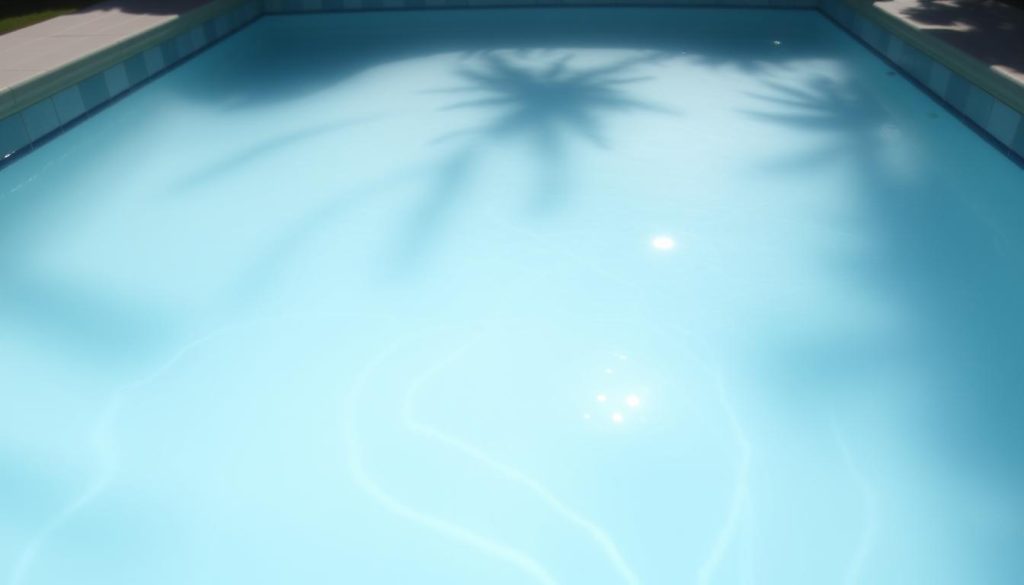
A cloudy white pool can be frustrating and uninviting. It’s a common issue for pool owners. Pool water cloudiness can stem from chemical imbalances, filtration issues, or algae growth.
Clear pool water clarity is vital for swimmer safety and aesthetics. Cloudy water may harbor harmful bacteria or contaminants. If ignored, it can damage your pool’s circulation system.
Identifying the cause is key to fixing cloudy water. Let’s explore common reasons for white pool water. We’ll provide pool maintenance tips and troubleshooting guides to restore crystal-clear water.
Key Takeaways
- Cloudy pool water can be caused by chemical imbalances, poor filtration, high calcium levels, or algae growth.
- Maintaining proper pH, chlorine, and alkalinity levels is crucial for preventing cloudiness.
- Regular backwashing of the filter and running the pool pump for at least 8 hours a day can help maintain water clarity.
- Shock treatments and pool clarifiers can be effective in clearing cloudy water caused by low chlorine levels or excess particles.
- Proper pool maintenance, including routine cleaning and chemical testing, is essential for preventing cloudy water and ensuring a safe swimming environment.
Common Causes of Cloudy White Pool Water
Cloudy white pool water frustrates many pool owners. Let’s explore the most common reasons behind this problem. We’ll provide insights on how to identify and address them effectively.
Chemical Imbalances
Chemical imbalances often cause cloudy white pool water. Low chlorine, high pH, and alkalinity issues can all contribute. Insufficient chlorine allows bacteria to thrive, leading to cloudy water.
The recommended pH range is 7.2 to 7.4. Alkalinity should be between 80 to 120 ppm. When these levels are off, the water becomes cloudy and uncomfortable.

Poor Filtration and Circulation
Inadequate filtration and circulation can cause cloudy white pool water. Clogged filters and poor water flow allow debris to accumulate. This results in a cloudy appearance.
Maintain a clean, well-functioning filtration system. Clean or replace filters regularly. Ensure the pump runs long enough to circulate water effectively.
| Filter Type | Cleaning Frequency | Replacement Frequency |
|---|---|---|
| Sand | Every 1-2 weeks | Every 5-7 years |
| Cartridge | Every 2-4 weeks | Every 1-2 years |
| D.E. | Every 1-2 months | Every 1-2 years |
High Calcium Hardness Levels
High calcium hardness can make pool water cloudy. When levels exceed 400 ppm, calcium scale forms on surfaces and equipment. This leads to a cloudy appearance.
Monitor calcium levels regularly. Use a calcium reducer when necessary. Consider partially draining and refilling the pool with fresh water.
Algae Growth
Algae can cause cloudy white water in early stages. It grows rapidly in warm, sunny conditions. Algae can reproduce every 3-6 hours if left unchecked.
Maintain proper chlorine levels to prevent algae growth. Brush pool surfaces regularly. Address any chemical imbalances promptly.
- Green algae: The most common type, causing green, cloudy water
- Yellow algae: Appears as yellow or mustard-colored spots on pool surfaces
- Black algae: Forms dark spots on pool surfaces and is difficult to remove
- Pink algae: Appears as a slimy, pinkish substance on pool surfaces
Diagnosing and Treating Cloudy White Pool Water
Cloudy white pool water needs proper diagnosis to find its cause. This involves pool water testing, chemistry analysis, filter inspection, and algae identification. These steps help determine the best way to restore crystal-clear water.
Diagnosing the Root Cause
Identifying the underlying problem is crucial for fixing cloudy pool water. Several factors can contribute, such as chemical imbalances, poor filtration, or algae growth. Investigating each potential cause helps pinpoint the source of cloudiness.
Testing Pool Water Chemistry
Regular pool water testing ensures a healthy and appealing swimming environment. It’s important to check that chemical levels are within recommended ranges. Here are key parameters to monitor:
| Parameter | Recommended Range |
|---|---|
| Free Chlorine (FC) | 1-3 ppm |
| Combined Chlorine (CC) | Below 0.5 ppm |
| pH | 7.2-7.8 |
| Total Alkalinity | 80-120 ppm |
| Calcium Hardness | 200-400 ppm |
| Cyanuric Acid (CYA) | 30-50 ppm |
If chemical imbalances are found, take corrective actions. This may include adjusting pH, adding chlorine, or using a clarifier. These steps help the filter remove fine particles more effectively.
Inspecting Filtration System
A working filtration system is key for clear pool water. Check the filter often and clean it when pressure readings are too high. This prevents debris buildup and helps remove contaminants from the water.
Run the pump and filter system for 8-12 hours daily. This ensures the entire pool water volume circulates at least once a day.
Identifying Algae Presence
Algae growth can cause cloudy pool water. It comes in various colors and multiplies quickly if left untreated. Look for discoloration or slimy patches on pool surfaces.
If you spot algae, use a shock treatment to eliminate it. Maintain proper water balance and chlorine levels to prevent future outbreaks.
Follow these steps to keep your pool water clear and inviting. Regular maintenance, including testing and cleaning, prevents issues before they arise. This ensures a healthy and appealing swimming environment.
Maintaining Crystal Clear Pool Water
Regular pool maintenance is crucial for sparkling clear water. A consistent cleaning schedule prevents cloudiness and ensures a safe swimming environment. Weekly water testing and adjustment of chlorine, pH, and alkalinity levels are essential.
The ideal pH range for chlorine-treated pools is 7.0 to 7.6. Bromine or salt-treated water should have a pH between 7.2 and 7.6.
Efficient filtration is vital for crystal clear pool water. Run the filtration system for at least 8 hours daily. This ensures proper water circulation and debris removal.
Regular backwashing of the filter maintains optimal pressure. It also removes trapped particles effectively. Clarifiers like Clear-Up Pool Clarifier can help bind smaller particles for better removal.
Preventive measures are key to maintaining clear pool water. Skim the pool surface daily to remove floating debris. Vacuum weekly to eliminate settled particles.
Brush pool walls and floor to prevent algae growth. Use algaecides and clarifiers for enhanced water clarity. Prompt action on issues keeps your pool crystal clear all season.







